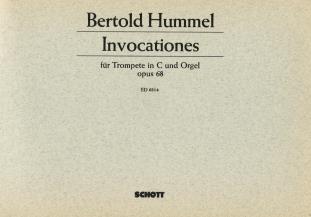Invocationes for Trumpet in C and Organ, op. 68a (1978)

I.
De profundis ![]() beginning
beginning
II. In te domine speravi
III. Non confundar in aeternum
Duration: 22 Minutes
Publisher: Schott Music ED 6814 / ISMN: 979-0-001-07227-4
| I. | II. | III. |
Video: Works by Hummel on youtube
Invocations:
1. "Aus der Tiefe rufe ich Herr zu dir..."("Out of the depths
I cry to thee, oh Lord..")
The 1st invocation bears the stamp
of musical material taken from the chorale "Aus tiefer Not schrei' ich
zu dir", initially more in brief motifs which undergo musical development
and interpenetrate each other. Towards the end of the movement (at the "sectio
aurea") the chorale melody is quoted - transposed successively line for line
by a whole tone. The melody is then lost again amidst motifs from the opening
invocation.
2. "Auf Dich Herr setze ich meine Hoffnung"("I
put my hope in you, Lord")
In the 2nd invocation, the solo instrument
takes up on a repeated note the speech rhythm of the Latin title. This expressive
technique recurs seven times during the movement, producing clear formal divisions.
The melodically and contrapuntally developed intermediate sections also show signs
of the speech melody of "In te domine speravi".
3. "La▀
mich nicht zu Schanden werden in Ewigkeit"("Let me not be confounded
eternally")
The 3rd invocation begins with an 8 note solo trumpet
call which recurs, often varied, in the following section with a culminating solo
cadenza for the trumpet. The 8 notes form the basis of the concluding Passacaglia,
in which the principal thoughts of all three movements reappear. The work, a commission
for the Organ Concert Series in the Freiburg Minster where it received its first
performance in 1978, dies away in extreme piano.
Bertold Hummel
"De
profundis", the first of the three "Invocations",
is based on the chorale "Aus tiefer Not schrei' ich zu dir" (after
the Psalm "From the depths I cry to you, oh Lord"). The organ
introduction expresses the "De profundis" ("From the
depths ") through a repeated descent from B-flat to A and
a pedal-point on E as a trill. After fanfare-like, constantly accelerating
tone repetitions, the solo instrument intones a motif formed out of the beginning
of the chorale melody and lets this sound on as an echo before then continuing
to freely weave the melody further. The organ passages then mount to increasingly
high levels of virtuosity, after which the saxophone presents the complete chorale
melody in free declamation, setting a very tranquil close with a double repetition
of the three last notes and then joining with the organ in a constantly intensifying
final section culminating in a triple forte with a brilliant tremolo (flutter-tonguing
in the trumpet).
The next two "Invocations" are based on
the the two final sections of the Te Deum. "In te Domine speravi"
("In you, Lord, have I hoped") starts with a recitation by the
solo instrument, corresponding to text, on f-sharp. Following an echo-like
repetition, the eight-note theme (quasi a setting of the text) enters espressivo,
is developed and - symbolising musically the increasing hope - intensified, until
the climax in fff brings the recitation to the note e, at which point the
Invocatio with theme and recitation gradually fades away as if to nothing.
"Non confundar in aeternum" ("Do not let me be confounded
for ever") is opened with the theme, forte and in half-notes, by
the solo instrument alone. Subsequently, the organ contributes an ostinato figure
in a manual and another in the pedals. The Invocatio leads into a large-scale
cadenza, fading out in an echo. Something of the "De profundis"
motif is to be heard again, its call for help answered by the "Non confundar
in aeternum", resounding in unshakeable faith (ostinato accompaniment!),
ebbing away then gradually in a triple piano.
The work was conceived
for trumpet and organ in 1978 as a commission for Freiburg Minster and received
its first performance on September 5th of the same year on the occasion of the
Catholic Convention.
Bertold Hummel
Press
Orchester 10/1981
Hummel uses liturgical invocations to make an expressive and deeply felt statement of faith in this work, in which a tonal, if harmonically and dynamically extremely bold trumpet part is combined with a completely contrasting organ part drawing on all resources available on the modern organ (concentrations of fortissimo outbursts; tone cluster-like massings; multifaceted beds of sound; hovering and fading beats in pianissimo). This gripping work wins over the listener with its rich treatment of familiar chorale themes.